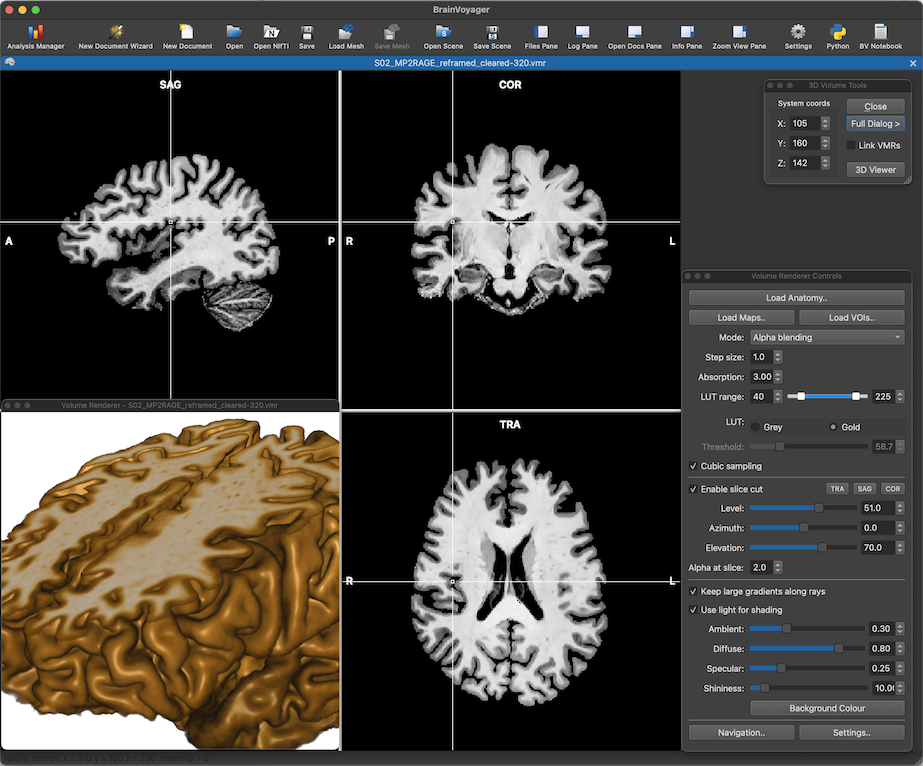Exhibition at Annual OHBM Meeting in Montreal, Canada
18 07, 23
If you are attending this years Human Brain Mapping conference in Montreal, Canada, please visit our booth (#206) and you'll meet BrainVoyager experts answering your questions! We are thrilled to show you several new applications and major updates of existing software, including BrainVoyager 23 with an amazing new volume renderer (see figure below). For the first time, BrainVoyager natively supports Apple Silicon hardware with Metal GPU performance that enables energy-efficient reproducible analyses of large datasets, beautiful real-time renderings and integration of native (arm64) Python as well as accelerated deep learning using TensorFlow. Because of the similarities between M1/M2 iPads and M1/M2 laptop and desktop Macs, desktop-quality BrainVoyager software will also be released for tablets - at our booth we demonstrate, for example, the beta version of BrainViewer for iPad with a touch-driven user interface. Like the recently released Brain Tutor 3D app, BrainViewer not only runs on all major desktop and mobile platforms but it also comes as a WebApp (based on WebAssembly) allowing to launch the app from most web browsers without installing anything. The BrainViewer app not only supports BrainVoyager files but also NIfTI and GIfTI files in a powerful app that can be used to visualise volume and surface datasets with overlaid regions, maps and invoked time courses. The app is so general that it can be used by BrainVoyager users as well as users of other software packages to inspect datasets and to create beautiful publication-ready figures and movies.
We also highlight our latest open source contributions to the software LayNII for state-of-the-art laminar and columnar fMRI analysis. We also present Turbo-BrainVoyager 4.4 that now supports multi-slice DICOM files (used increasingly by SIEMENS) and NIfTI files (used by PHILIPS). TBV 4.4 also comes with a new real-time data simulator that is also included in the Turbo-BrainVoyager 4.4 EDU version. Our EDU products are the ideal tools to teach (e.g. in courses) and (self-)learn how to analyse and visualise structural and functional neuroimaging data from basic to advanced tools including scripting and programming using Python. In our partnership with NIRx (booth #202), we are excited to present the latest version of our real-time fNIRS software Turbo-Satori and a major new version of our fNIRS offline software Satori that now integrates calls into Python tools, for example, in graphically designed data processing workflows.

We also highlight our latest open source contributions to the software LayNII for state-of-the-art laminar and columnar fMRI analysis. We also present Turbo-BrainVoyager 4.4 that now supports multi-slice DICOM files (used increasingly by SIEMENS) and NIfTI files (used by PHILIPS). TBV 4.4 also comes with a new real-time data simulator that is also included in the Turbo-BrainVoyager 4.4 EDU version. Our EDU products are the ideal tools to teach (e.g. in courses) and (self-)learn how to analyse and visualise structural and functional neuroimaging data from basic to advanced tools including scripting and programming using Python. In our partnership with NIRx (booth #202), we are excited to present the latest version of our real-time fNIRS software Turbo-Satori and a major new version of our fNIRS offline software Satori that now integrates calls into Python tools, for example, in graphically designed data processing workflows.


